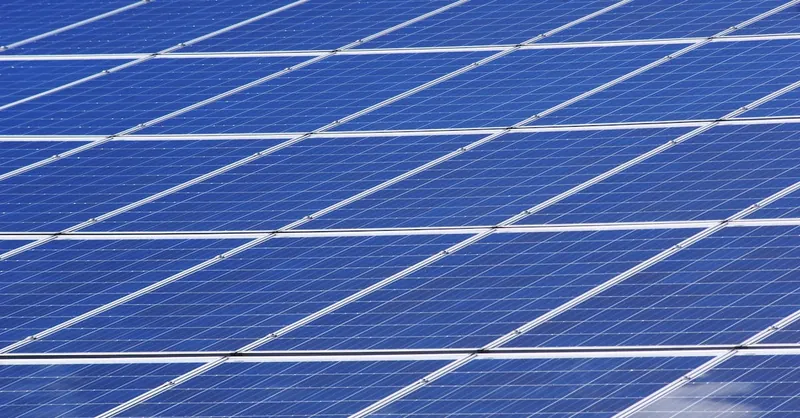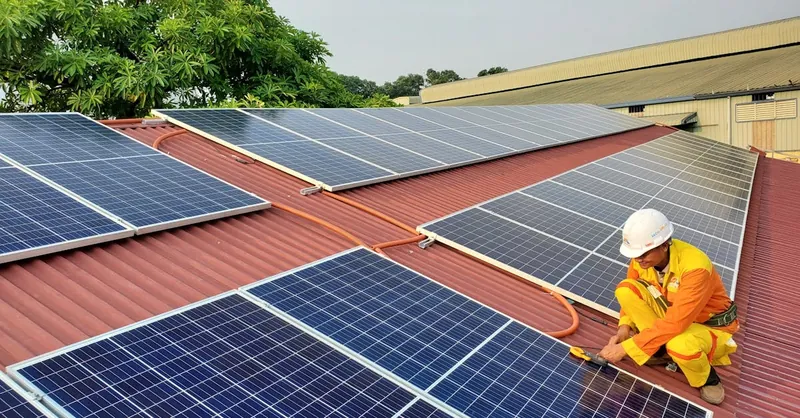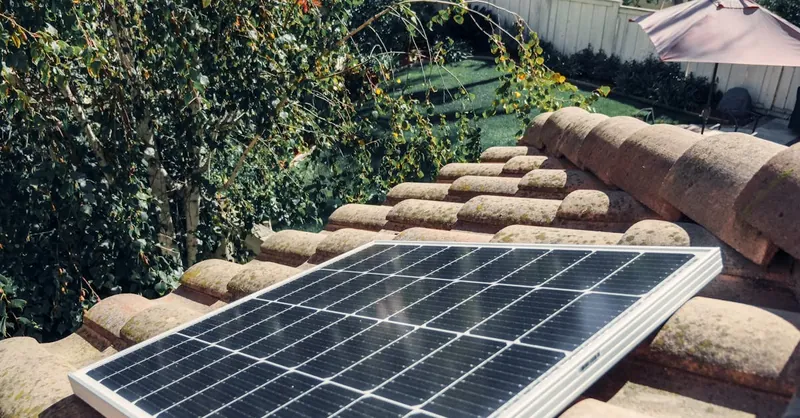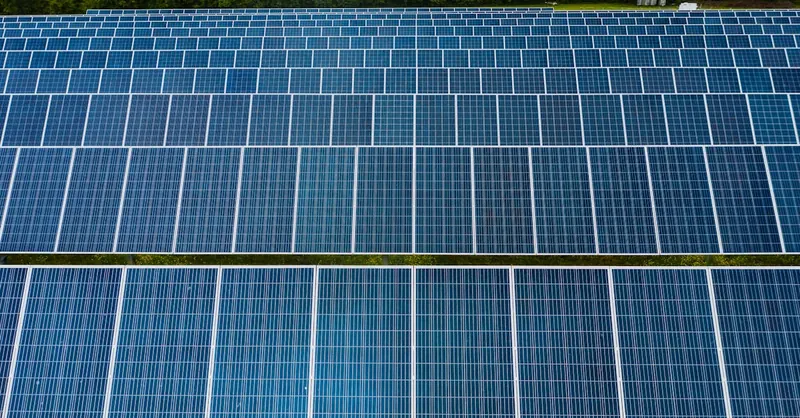Solar Thermal Energy Systems Explained: Science & Innovation
Category: Renewable Energy
Unlocking the Power of Solar Thermal Energy Systems
Whether you're an electrical engineer delving into renewable technologies or a curious beginner eager to grasp the science behind solar thermal energy systems, you've landed in the right place. Navigating complex jargon and piecing together fragmented information can be daunting. You want clear, in-depth insights that elucidate how solar thermal systems work, their components, innovations, and real-world applications—with a scientific yet accessible approach. This blog post addresses your need for a structured and thorough understanding, bridging foundational concepts with cutting-edge innovations in the field. Unlike generic overviews, here you’ll discover a seamless flow from basic principles to advanced system analysis, including emerging designs that are shaping the future of sustainable energy. Prepare to deepen your knowledge and uncover how solar thermal systems convert sunlight into usable heat efficiently, ultimately expanding your grasp of renewable technologies. Dive in, and let's explore the fascinating mechanics and innovations powering solar thermal energy today.
- Unlocking the Power of Solar Thermal Energy Systems
- Fundamentals of Solar Thermal Energy
- Types of Solar Thermal Systems
- Core Components Explained: Collectors, Heat Transfer Fluids, Storage Tanks, and Heat Exchangers
- Working Principles and System Design: How Solar Thermal Systems Operate
- Applications of Solar Thermal Energy Systems
- Efficiency Factors and Performance Metrics in Solar Thermal Energy Systems
- Innovations and Emerging Technologies in Solar Thermal Energy Systems
- Installation, Maintenance, and Economic Considerations in Solar Thermal Energy Systems
- Environmental Impact and Sustainability Benefits of Solar Thermal Energy Systems
- Future Trends and Challenges in Solar Thermal Energy Systems
Fundamentals of Solar Thermal Energy
At its core, solar thermal energy harnesses the sun’s radiant heat to produce thermal energy, a process fundamentally different from photovoltaic (PV) systems that convert sunlight directly into electricity. The science behind solar thermal technology involves capturing solar radiation—primarily in the form of infrared and visible light—and using specialized collectors to absorb and concentrate this energy, elevating temperatures for practical use.
The basic mechanism relies on solar collectors, which absorb sunlight and convert it into heat. This heat is then transferred to a working fluid—often water, oil, or air—that circulates through the system, delivering thermal energy for applications such as residential water heating, industrial process heat, or even electricity generation via steam turbines. Unlike PV panels where photons excite electrons to create electrical current, solar thermal systems focus on maximizing heat absorption and minimizing thermal losses, emphasizing efficient heat transfer rather than electrical conversion.
Key Differences Between Solar Thermal and Photovoltaic Systems
- Energy Conversion Process
- Solar thermal systems convert solar radiation directly into heat energy.
-
Photovoltaic systems convert solar radiation into electrical energy via the photovoltaic effect.
-
System Components
- Thermal systems use collectors, heat exchangers, and storage tanks.
-
PV systems rely on semiconductor-based solar cells and inverters.
-
Efficiency and Application
- Solar thermal tends to achieve higher efficiency in heat generation (up to 70%) for heating applications.
-
Photovoltaics typically convert 15-22% of sunlight into electricity, which can then be used for a wide range of electrical needs.
-
Energy Storage
- Thermal energy storage can be efficiently done using phase change materials or insulated water tanks.
- Electrical energy storage usually requires batteries or other electrical storage solutions.
Understanding these fundamental distinctions not only clarifies how solar thermal technology fits into the renewable energy landscape but also highlights its unique advantages for heating and industrial uses where direct heat is required efficiently and cost-effectively. This foundational knowledge sets the stage for deeper exploration of solar thermal system designs and innovations.

Image courtesy of Kindel Media
Types of Solar Thermal Systems
Solar thermal energy systems are broadly categorized based on the temperature ranges they operate in, which directly influence their design, complexity, and typical applications. Understanding these categories—low-temperature, medium-temperature, and high-temperature solar thermal systems—is crucial for selecting the appropriate technology for specific energy needs, whether in residential, commercial, or industrial contexts.
1. Low-Temperature Solar Thermal Systems (<100°C)
Low-temperature systems primarily provide direct heating solutions and are among the most widely deployed solar thermal technologies. These systems typically use simple flat-plate collectors or unglazed collectors, offering efficient heat generation for tasks such as:
- Domestic hot water heating
- Space heating in residential and commercial buildings
- Pool heating systems
Due to their relatively low operating temperatures, these systems are cost-effective, easy to install, and ideal for everyday heating applications where water or air temperatures need only moderate elevation.
2. Medium-Temperature Solar Thermal Systems (100°C to 400°C)
Medium-temperature systems utilize more sophisticated collectors, such as evacuated tube collectors or parabolic troughs, to achieve higher temperatures. These systems are suited for:
- Industrial process heat
- Enhanced space heating
- Solar cooling when combined with absorption chillers
They strike a balance between efficiency and cost while enabling more diverse applications such as food processing, chemical manufacturing, and medium-scale district heating networks.
3. High-Temperature Solar Thermal Systems (>400°C)
High-temperature solar thermal technologies focus on concentrated solar power (CSP) systems, which employ mirrors or lenses to concentrate sunlight onto a small receiver, generating extremely high temperatures. Common technologies include:
- Parabolic troughs
- Central receiver (solar tower) systems
- Dish Stirling engines
These systems are primarily designed for electricity generation via steam turbines or combined heat and power (CHP) plants and can also drive thermochemical reactions. Their ability to reach temperatures above 400°C makes them suitable for large-scale power plants and industrial processes requiring substantial thermal energy.
By distinguishing solar thermal systems according to their operating temperature ranges and typical uses, engineers and enthusiasts alike can better appreciate the versatility and scalability of solar thermal technologies across sectors. This classification not only guides system selection but also informs ongoing innovation aimed at optimizing performance and expanding applications in the renewable energy landscape.

Image courtesy of Los Muertos Crew
Core Components Explained: Collectors, Heat Transfer Fluids, Storage Tanks, and Heat Exchangers
Solar thermal energy systems rely on several critical components that work synergistically to capture, transfer, and store thermal energy efficiently. A detailed understanding of these parts is essential for both beginners and electrical engineers seeking to optimize system performance or innovate in design.
1. Solar Collectors: Types and Functions
The solar collector is the heart of any solar thermal setup, responsible for absorbing solar radiation and converting it into heat. The choice of collector impacts system efficiency, operating temperature, and application scope.
-
Flat-Plate Collectors
Typically used in low to medium-temperature systems, flat-plate collectors consist of an insulated, weatherproof box containing a dark absorber plate and a transparent cover (usually glass). They absorb solar radiation and transfer heat to a fluid flowing through tubes attached to the absorber. Their simplicity and durability make them ideal for domestic hot water and space heating. -
Evacuated Tube Collectors
Designed for higher efficiency and temperatures, these collectors use parallel glass tubes with a vacuum between the absorber and the outer glass to reduce heat loss. The vacuum insulation minimizes conductive and convective heat losses, making evacuated tubes suitable for medium-temperature applications like industrial process heat or solar cooling. -
Concentrating Collectors
Concentrators like parabolic troughs, linear Fresnel lenses, and solar dish systems use mirrors or lenses to focus sunlight onto a small receiver, achieving high temperatures (often above 400°C). These collectors enable high-temperature thermal energy capture, making them a backbone of large-scale power generation via Concentrated Solar Power (CSP) plants.
2. Heat Transfer Fluids (HTFs)
A heat transfer fluid circulates through the solar collector to absorb and carry thermal energy to storage or direct-use points. The choice of HTF depends on temperature requirements, thermal stability, and cost considerations.
- Water: Common in low-temperature systems, water is an effective, non-toxic, and inexpensive HTF but susceptible to freezing and boiling issues.
- Glycol-Water Mixtures: Added antifreeze properties make glycols suitable for climates where freezing is a risk.
- Thermal Oils: High-temperature stable synthetic oils are preferred in medium and some high-temperature systems to withstand temperatures above the boiling point of water without pressurization.
- Molten Salts: Used primarily in high-concentration CSP plants, molten salts serve as both HTF and thermal storage medium due to their high heat capacity and stability at temperatures exceeding 500°C.
3. Storage Tanks and Thermal Energy Storage
Efficient thermal energy storage is pivotal in managing the intermittent nature of solar energy, enabling heat availability during cloud cover or nighttime. Storage tanks—usually well-insulated and made of materials resistant to corrosion—hold the HTF or heated water.
- Storage tanks may be stratified to maintain thermal layers, optimizing heat extraction.
- Advanced systems incorporate phase change materials (PCMs) inside or around tanks to store latent heat, improving storage density and reducing tank size.
4. Heat Exchangers
Heat exchangers facilitate the transfer of thermal energy between the solar-heated fluid and the application medium (such as potable water or process fluids) without mixing the two fluids. They enhance system safety and efficiency by isolating the collector loop from the end use.
- Common types include plate heat exchangers and shell-and-tube heat exchangers, chosen based on operating temperatures, pressure requirements, and fluid compatibility.
- Heat exchanger design affects thermal losses and system responsiveness, making it a vital component in optimizing overall solar thermal system performance.
By mastering the functions and characteristics of these core components—collectors, heat transfer fluids, storage tanks, and heat exchangers—engineers and enthusiasts can better design, evaluate, and innovate solar thermal energy systems suited to diverse applications and climatic conditions. This comprehensive understanding also aids in identifying opportunities for material improvements and system integration, driving forward the advancement of sustainable solar thermal technologies.

Image courtesy of Jay Brand
Working Principles and System Design: How Solar Thermal Systems Operate
At the heart of every solar thermal energy system lies a sophisticated yet elegant process of solar heat capture, transfer, and storage that transforms sunlight into usable thermal energy. Understanding these working principles is essential for both beginners aiming to grasp the fundamentals and engineers looking to optimize system design.
Heat Capture: Converting Solar Radiation to Thermal Energy
The process begins with solar collectors absorbing solar radiation—a mix of visible, infrared, and ultraviolet light. These collectors are engineered to maximize absorption while minimizing reflection and heat loss. Once sunlight strikes the absorber surface, the energy is converted into heat. Depending on the system type:
- Flat-plate and evacuated tube collectors absorb solar radiation efficiently for low to medium temperature ranges, heating a circulating fluid inside tubes or channels.
- Concentrating collectors (e.g., parabolic troughs or solar towers) increase heat intensity by focusing sunlight onto a small receiver, enabling high-temperature heat generation for electricity or industrial processes.
Heat Transfer: Circulating Thermal Energy Through the System
The absorbed heat is transferred to a working fluid—commonly water, glycol mixtures, thermal oils, or molten salts—that moves through the collector loop. The design of the heat transfer circuit is critical to maintain thermal efficiency and system reliability. Key considerations include:
- Closed-loop vs. open-loop configurations — Closed loops prevent contamination and corrosion, often featuring heat exchangers separating the collector fluid from the end-use fluid.
- Pump and flow control systems — Variable-speed pumps and smart controllers regulate fluid flow based on solar intensity, optimizing heat capture while preventing overheating or freezing.
- Thermal insulation — Minimizing heat losses in piping and collector enclosures preserves energy for downstream use.
Thermal Energy Storage: Ensuring Continuous Heat Availability
Because solar irradiance fluctuates daily and seasonally, integrating thermal energy storage (TES) is vital for consistent energy supply. Storage systems commonly use:
- Sensible heat storage through insulated tanks holding heated water or thermal oils.
- Latent heat storage utilizing phase change materials (PCMs) that store and release heat via phase transitions, increasing energy density and stabilizing output temperatures.
Coupled with system controls, thermal storage balances supply and demand, enabling heat delivery during nighttime or cloudy periods without additional fuel inputs.
Simplified Schematic Overview for Solar Thermal Systems
- Solar Collector: Absorbs sunlight → converts to heat.
- Heat Transfer Loop: Circulates heated fluid → transports thermal energy.
- Heat Exchanger (if present): Transfers heat to end-use fluid or process without mixing fluids.
- Thermal Storage Tank: Stores heat for later use.
- Demand Side: Utilizes heat for water heating, space heating, industrial processes, or power generation.
This flow embodies the fundamental design of solar thermal systems, with variations tailored to temperature requirements and scale. By mastering these operational principles, system designers can improve efficiency, reduce costs, and innovate new configurations that push the boundaries of solar thermal technology.

Image courtesy of Sasha P
Applications of Solar Thermal Energy Systems
Solar thermal energy systems have a wide range of diverse applications that leverage their ability to efficiently convert sunlight into usable heat. These applications span from residential uses to large-scale industrial processes and cutting-edge niche technologies, demonstrating the versatility and growing importance of solar thermal solutions in the renewable energy landscape.
Residential Heating and Hot Water Supply
One of the most prevalent applications of solar thermal energy is in residential heating. Solar thermal collectors are commonly installed on rooftops to provide:
- Domestic hot water heating, significantly reducing reliance on conventional water heaters powered by electricity or fossil fuels.
- Space heating through solar-assisted radiant floor systems or integrated HVAC solutions.
- Support for solar cooling, where heat generated by solar collectors drives absorption chillers for air conditioning, offering an energy-efficient alternative in hot climates.
These residential systems not only lower energy bills but also reduce household carbon footprints, making them an accessible entry point for adopting renewable thermal energy.
Industrial Process Heat
In the industrial sector, solar thermal technologies serve as a renewable source of process heat, particularly for medium-temperature applications up to 400°C or higher. Key industries benefiting include:
- Food and beverage processing (e.g., pasteurization, cooking, drying)
- Chemical manufacturing requiring stable heat supply
- Textile production where precise temperature control enhances efficiency
- Metal plating and treatment operations
Using solar thermal systems in these contexts helps reduce dependency on fossil fuels, lowers operational costs, and aligns industries with sustainability targets.
Power Generation via Concentrated Solar Power (CSP)
At the high-temperature end, Concentrated Solar Power (CSP) plants utilize advanced solar thermal collectors—like parabolic troughs, solar towers, and dish Stirling systems—to generate electricity on a utility scale. In CSP:
- Sunlight is concentrated to heat a working fluid to temperatures exceeding 400°C.
- The thermal energy drives steam turbines coupled with generators to produce electricity reliably.
- Thermal energy storage (e.g., molten salt tanks) often complements CSP, enabling electricity generation even when the sun is not shining, ensuring grid stability.
CSP plants provide a renewable, dispatchable power solution that complements intermittent solar PV and wind energy, enhancing overall grid resilience.
Emerging Niche Applications
Beyond conventional heating and power generation, solar thermal energy systems enable innovative niche applications that address critical global challenges:
- Desalination: Solar thermal-driven multi-effect distillation (MED) and membrane distillation processes use concentrated heat to efficiently convert seawater into potable water, offering a sustainable solution to water scarcity.
- Solar Cooling: Solar thermal absorption chillers harness heat to produce chilled water for cooling buildings, reducing electricity consumption associated with traditional air conditioning.
- Industrial drying and sterilization: Solar heat accelerates drying processes in agriculture and medical sanitation, promoting energy-efficient operations.
- Hybrid renewable systems: Integration with biomass or geothermal heat sources creates hybrid setups that optimize energy use based on availability and demand.
By expanding into these innovative applications, solar thermal energy systems showcase their adaptability and potential to tackle environmental and socio-economic challenges worldwide.
Solar thermal energy’s broad spectrum of applications—from residential heating to industrial process heat and large-scale power generation—illustrates its vital role in the global transition toward sustainable energy. Understanding these applications enables engineers and enthusiasts to identify opportunities for deploying solar thermal technologies that maximize energy efficiency, reduce emissions, and foster innovation across sectors.

Image courtesy of Kindel Media
Efficiency Factors and Performance Metrics in Solar Thermal Energy Systems
Maximizing the efficiency of solar thermal energy systems is essential for achieving optimal performance and economic viability. Several interrelated factors influence system efficiency, including the available solar resource, the design and materials of solar collectors, thermal losses, and the accuracy of performance evaluation methods. Understanding these key parameters enables engineers and system designers to fine-tune installations, select appropriate components, and predict energy output with greater precision.
Key Parameters Affecting System Efficiency
-
Insolation (Solar Irradiance)
Insolation refers to the intensity of solar radiation received per unit area, typically measured in kWh/m²/day. It is the fundamental driver of system output, varying by geographic location, time of year, atmospheric conditions, and shading. High insolation levels directly contribute to increased energy capture, but variability necessitates robust system design and storage solutions to maintain steady thermal supply. -
Collector Efficiency
Collector efficiency defines the ability of solar collectors to convert incident solar radiation into usable heat. It is influenced by: - Absorber material properties (absorptivity and emissivity)
- Collector design and insulation
- Optical losses (reflection and transmission through glazing)
- Fluid flow rates and heat transfer coefficients
Efficiency typically decreases as the temperature difference between the collector surface and ambient air increases due to higher thermal losses.
- Thermal Losses
Heat losses occur primarily through convection, conduction, and radiation from the collector and piping system. Key contributors include: - Thermal conduction through collector materials and insulation
- Convective heat loss from exposed surfaces
- Radiation losses from absorber plates at elevated temperatures
- Heat loss during fluid transport, especially over long distances or poorly insulated piping
Minimizing these losses through advanced insulation, vacuum technologies (e.g., evacuated tube collectors), and optimized system layout enhances overall performance.
Methods for Performance Evaluation
Performance metrics and analytical methods are critical for assessing solar thermal systems, facilitating monitoring, comparison, and optimization. Common approaches include:
-
Instantaneous Efficiency (η):
[ η = \frac{Q_u}{I \times A_c} ]
Where (Q_u) is useful thermal energy gained, (I) is solar irradiance, and (A_c) is collector aperture area. This metric assesses collector effectiveness under specific operating conditions. -
Thermal Energy Output (Q_u):
Calculated as:
[ Q_u = \dot{m} \times c_p \times (T_{out} - T_{in}) ]
Where (\dot{m}) is mass flow rate, (c_p) is specific heat capacity, and (T_{out}), (T_{in}) are outlet and inlet fluid temperatures respectively. -
Performance Ratio (PR):
The ratio of actual energy output to theoretical output based on solar input, accounting for system losses and real-world conditions. -
Seasonal Performance Factor (SPF):
Evaluates system efficiency across different seasons or operating periods, vital for long-term performance assessments. -
Standardized Testing and Simulation:
Using test protocols such as ISO 9806 or TRNSYS simulations allows reproducible efficiency determination and system behavior prediction under varying climates and loads.
By carefully analyzing these efficiency factors and performance metrics, stakeholders can design solar thermal energy systems that maximize heat capture, minimize losses, and deliver reliable thermal energy. This scientific approach supports continuous innovation, cost reduction, and greater penetration of solar thermal technologies in both residential and industrial renewable energy applications.

Image courtesy of Pixabay
Innovations and Emerging Technologies in Solar Thermal Energy Systems
Solar thermal energy systems are rapidly evolving, driven by breakthroughs in advanced materials, innovative hybrid configurations, and sophisticated integration with energy storage and control technologies. These innovations are crucial for enhancing system efficiency, reducing costs, and improving the overall sustainability and reliability of solar thermal solutions.
Advanced Materials Enhancing Performance and Durability
Cutting-edge materials are revolutionizing solar thermal collectors and components by improving solar absorption, minimizing thermal losses, and extending operational life. Key developments include:
- Selective coatings with high solar absorptance and low emissivity, dramatically reducing radiative heat losses.
- Nanostructured surfaces engineered for enhanced light trapping and reduced reflection, increasing collector efficiency in low-light conditions.
- Thermally stable polymers and corrosion-resistant alloys that enable high-temperature operation in harsh environments while lowering maintenance needs.
- Phase Change Materials (PCMs) embedded in thermal storage systems to boost energy density and provide stable temperature regulation during energy discharge.
Hybrid Solar Thermal Systems
Hybrid systems combine solar thermal technology with complementary renewable or conventional energy sources to optimize performance and broaden application scopes. Examples include:
-
Photovoltaic-Thermal (PVT) Hybrid Collectors: These systems simultaneously generate electrical energy via photovoltaic cells and capture thermal energy using integrated solar thermal collectors. This maximizes land use and overall energy yield, making PVT solutions attractive for building-integrated renewable energy generation.
-
Solar Thermal-Biomass Hybrid Plants: By blending solar thermal heat with biomass combustion, these hybrids ensure continuous heat supply, especially under low solar insolation, enhancing system reliability for industrial heating applications.
-
Combined Solar Thermal and Heat Pumps: Integrating solar thermal collectors with heat pump systems increases heating efficiency, enabling cost-effective low-temperature heating and cooling solutions in residential and commercial buildings.
Integration with Advanced Energy Storage Solutions
The intermittent nature of solar irradiance necessitates advanced thermal energy storage (TES) technologies to ensure steady heat supply. Emerging innovations include:
- High-capacity sensible heat storage using optimized insulated tanks with stratification to minimize thermal mixing.
- Latent heat storage employing next-generation PCMs with tailored melting points for specific applications, boosting storage compactness and performance.
- Thermochemical storage systems that store energy through reversible chemical reactions, promising higher energy densities and longer storage durations for utility-scale solar thermal plants.
These storage advancements enable solar thermal systems to deliver dispatchable, on-demand heat and power, integrating smoothly with grid needs and industrial schedules.
Cutting-Edge Control Systems and Smart Integration
Innovative control strategies and IoT-enabled monitoring are transforming solar thermal system management by maximizing efficiency and system longevity:
- Predictive control algorithms that adjust fluid flow rates and system operation based on weather forecasts, load demands, and real-time sensor data reduce energy wastage and prevent overheating or freezing.
- Demand-side management integration allows solar thermal systems to operate synergistically with other renewables, smart grids, and energy storage, optimizing overall energy use.
- Remote monitoring and diagnostics powered by machine learning enhance preventive maintenance, minimize downtime, and support data-driven system improvements.
By embracing these technological advances—from advanced materials and hybrid system designs to sophisticated energy storage and control mechanisms—solar thermal energy is positioned to become more efficient, reliable, and scalable. These innovations pave the way for broader adoption across residential, commercial, and industrial sectors, reinforcing solar thermal energy’s critical role in the global transition to sustainable renewable energy systems.

Image courtesy of Kindel Media
Installation, Maintenance, and Economic Considerations in Solar Thermal Energy Systems
Successful deployment and long-term operation of solar thermal energy systems hinge not only on technical design but also on practical aspects such as installation quality, ongoing maintenance, and economic feasibility. These factors collectively influence system performance, reliability, return on investment, and widespread adoption.
Installation: Best Practices for Optimal Performance
Proper system installation is crucial to ensure maximum solar energy capture and efficient heat delivery. Key considerations include:
-
Site Assessment and Orientation
Selecting a location with unobstructed access to sunlight, preferably south-facing (in the northern hemisphere) or north-facing (in the southern hemisphere), minimizes shading and optimizes solar irradiance absorption throughout the year. -
Mounting and Structural Support
Secure mounting frameworks must accommodate local wind loads, snow accumulation, and seismic activity while providing the correct tilt angle for seasonally adjusted solar exposure. -
Hydraulic and Electrical Integration
Careful connection of fluid piping, pumps, valves, and control systems ensures leak-free operation and efficient heat transfer. Proper insulation of piping minimizes thermal losses, enhancing overall system efficiency. -
System Commissioning and Testing
After installation, calibrating sensors, verifying flow rates, and performing pressure tests contribute to safe, reliable operation and identify potential issues before system commissioning.
Maintenance: Ensuring Longevity and Efficiency
Regular preventive maintenance extends system lifespan and preserves performance by addressing wear, contamination, and component degradation. Essential maintenance tasks include:
- Periodic inspection of collectors for dirt, dust, and debris accumulation, which can significantly reduce solar absorption if left uncleaned.
- Checking heat transfer fluids for appropriate levels, contamination, and antifreeze properties especially in colder climates.
- Monitoring pumps and valves for proper operation and prompt replacement of malfunctioning parts.
- Inspecting storage tanks and heat exchangers for corrosion, sediment buildup, and insulation integrity.
- Control system updates and sensor calibration to maintain precise operation and responsiveness.
Implementing remote monitoring solutions can enhance maintenance efficiency through real-time performance tracking and early fault detection, reducing downtime.
Economic Considerations: Cost-Benefit Analysis and Incentives
Understanding the economics of solar thermal energy systems is vital to justify initial investments and ongoing expenditures:
-
Capital and Installation Costs
Initial expenses cover collectors, storage tanks, piping, pumps, control units, and labor for installation. Costs vary based on system size, complexity, and technology type (e.g., flat-plate vs. concentrated collectors). -
Operational Costs
Operational expenditures are relatively low compared to fossil fuel alternatives, primarily including maintenance, periodic fluid replacement, and potential component upgrades. -
Energy Savings and Payback Period
Savings depend on local energy prices, solar resource availability, and system efficiency. Payback periods typically range from 3 to 10 years, with commercial and industrial systems often realizing shorter returns due to larger-scale heat demand. -
Government Incentives and Subsidies
Many regions offer financial incentives such as tax credits, rebates, low-interest loans, or feed-in tariffs to encourage solar thermal adoption. Leveraging these programs can significantly improve project economics. -
Lifecycle Cost Analysis
Evaluating total cost of ownership—including installation, maintenance, energy savings, and residual value—enables accurate assessment of long-term financial benefits and environmental impact.
By adhering to best installation practices, maintaining rigorous upkeep, and conducting thorough economic analyses including leveraging available incentives, solar thermal energy systems become not only technically viable but also financially attractive. These practical insights empower engineers, installers, and consumers to make informed decisions that accelerate the deployment and success of solar thermal technologies in the renewable energy transition.

Image courtesy of Trinh Trần
Environmental Impact and Sustainability Benefits of Solar Thermal Energy Systems
Solar thermal energy systems play a pivotal role in reducing carbon emissions and promoting a sustainable energy future. By harnessing the sun’s abundant and clean thermal power to produce heat, these systems significantly cut dependence on fossil fuels such as coal, natural gas, and oil, which are major contributors to greenhouse gas emissions. Unlike combustion-based heat generation, solar thermal technologies operate with zero direct emissions, offering a clean alternative that helps mitigate climate change and improve air quality.
Contributions to Carbon Emission Reduction
- Displacement of Fossil Fuels: Solar thermal systems replace traditional heating sources in residential, commercial, and industrial settings, directly lowering CO₂ and other pollutant emissions associated with burning fossil fuels.
- Energy Efficiency: These systems achieve high thermal conversion efficiencies (often exceeding 60-70%), which means more of the solar energy is effectively utilized as heat, minimizing energy waste and further reducing environmental impact.
- Lifecycle Emissions: When considering the full lifecycle—including manufacturing, installation, and operation—solar thermal energy still vastly outperforms fossil fuel technologies in terms of net greenhouse gas emissions, making it a sustainable option over decades of service.
Broader Sustainability Benefits
- Resource Conservation: Solar thermal systems reduce the need for finite natural resources by relying on the inexhaustible solar resource, decreasing pressure on water and fuel extraction activities that often have detrimental ecological effects.
- Reduced Air and Water Pollution: By eliminating combustion, solar thermal energy reduces emissions of sulfur dioxide (SO₂), nitrogen oxides (NOₓ), particulate matter, and toxic pollutants, which are harmful to human health and ecosystems.
- Support for Circular Economy Principles: Many solar thermal components are recyclable or made from abundant materials, and advancements in durable coatings and materials extend system lifespans, reducing waste and promoting material sustainability.
- Integration with Decentralized Energy Systems: Solar thermal installations can be decentralized, reducing transmission losses and enhancing local energy resilience while empowering communities to adopt cleaner, low-carbon energy solutions.
In summary, solar thermal energy systems provide a strategic pathway to decarbonize heat generation, which accounts for a substantial portion of global energy consumption. Their sustainable operation, high efficiency, and environmental benefits align closely with global climate goals such as the Paris Agreement, making solar thermal energy a cornerstone technology in achieving a greener and more resilient energy future.

Image courtesy of Kindel Media
Future Trends and Challenges in Solar Thermal Energy Systems
As the global push toward renewable energy intensifies, solar thermal energy systems are poised to play a critical role in diversifying and decarbonizing thermal energy supply. Ongoing research and development efforts focus on overcoming key technological challenges while unlocking new potentials for scalability, efficiency, and integration.
Emerging Research and Technological Innovations
-
Next-Generation Concentrating Solar Power (CSP) Technologies
Researchers are developing advanced CSP configurations such as multi-tower solar fields, volumetric receivers, and novel heat transfer fluids that can operate at ultra-high temperatures (>700°C). These innovations aim to boost thermal-to-electric conversion efficiency, lower costs, and enable longer-duration thermal energy storage, directly addressing intermittency issues in renewable grids. -
Advanced Thermal Energy Storage (TES) Solutions
Breakthroughs in thermochemical and latent heat storage materials offer prospects for compact, high-density, and long-duration energy storage. These advancements will facilitate dispatchable solar heat and power, enabling solar thermal plants to provide round-the-clock energy and stabilize variable renewable energy portfolios. -
Hybridization and System Integration
Integration of solar thermal systems with complementary technologies—such as photovoltaics, energy storage, heat pumps, and smart grid controls—is becoming a focal research area. Hybrid systems maximize overall energy yield, improve reliability, and tailor heat and power delivery to match dynamic demand profiles, supporting the transition to decentralized and flexible energy systems.
Key Technological Hurdles and Challenges
-
Cost Competitiveness and Material Durability
Despite progress, high initial capital costs and material limitations (e.g., thermal degradation of heat transfer fluids or coatings) can impede widespread adoption. Innovations to develop low-cost, robust materials and modular system designs are crucial to enhancing economic viability and long-term operation. -
Scaling for Diverse Applications
While large-scale CSP plants offer utility-grade power, scaling solar thermal solutions efficiently for small and medium industrial or residential applications remains challenging. The development of adaptable, standardized systems that cater to varied thermal demands without compromising efficiency is a priority. -
System Complexity and Maintenance
Sophisticated control systems and hybrid configurations introduce operational complexity, requiring skilled maintenance and monitoring infrastructure. Addressing these challenges through automation, predictive maintenance, and user-friendly designs will improve reliability and reduce lifecycle costs.
The Potential Role of Solar Thermal Energy in Global Renewable Portfolios
Solar thermal energy uniquely complements other renewables by directly addressing the thermal energy demand—a sector responsible for nearly half of total global energy consumption—and by enabling thermal energy storage more efficiently than electrical batteries. Its ability to provide high-temperature heat for industrial processes, desalination, and dispatchable power generation positions it as a strategic technology for deep decarbonization.
Countries with abundant solar resources are increasingly incorporating solar thermal systems into their renewable energy strategies, combining CSP with thermal storage to ensure grid stability and energy security. Moreover, advances in distributed solar thermal heating and cooling solutions empower communities and industries to reduce fossil fuel dependence locally.
In summary, continued innovation, cost reduction, and system integration will determine the pace at which solar thermal energy becomes a foundational element of future renewable energy portfolios—transforming how the world captures, stores, and utilizes the sun's immense thermal power.

Image courtesy of Kelly
